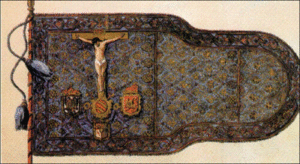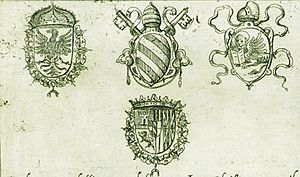Holy League (1571) facts for kids
Quick facts for kids Holy League (1571) |
|
|---|---|
| Ideology | Catholicism |
| Founder | Pope Pius V |
| Allies | |
| Opponents | Ottoman Empire |
The Holy League was a powerful alliance formed in 1571. It was put together by Pope Pius V. This group brought together the main Catholic countries in southern Europe. These included the Spanish Empire and important Italian sea powers.
The main goal of the Holy League was to stop the Ottoman Empire from controlling the eastern Mediterranean Sea. The alliance was officially created on May 25, 1571.
Its members included:
- The Papal States, led by Pope Pius V.
- The Spanish Empire, led by King Philip II. This included Naples and Sicily.
- The Republic of Venice.
- The Republic of Genoa.
- The Knights of Malta.
- The Grand Duchy of Tuscany and the Order of Saint Stephen, led by Cosimo I de' Medici.
- The Duchy of Savoy, led by Emmanuel Philibert.
- The Duchy of Urbino, led by Guidobaldo II della Rovere.
- The Duchy of Parma, led by Ottavio Farnese.
These Christian states planned to have a large fighting force ready each year. This force would include 200 galleys, 100 other ships, 50,000 foot soldiers, 4,500 horsemen, and enough cannons. John of Austria, who was King Philip II's half-brother, was chosen to be the supreme commander.
The League hoped other powerful countries would join. They invited the Holy Roman Empire, France, and Portugal. However, none of them joined the alliance. The Holy Roman Empire wanted to keep its peace agreement with the Ottomans. France had an alliance with the Ottomans against Spain. Portugal was busy with its own wars in Morocco and conflicts in the Red Sea and Indian Ocean.
The Battle of Lepanto
The Holy League first gathered its fleet to help the city of Venice. Venice was defending Cyprus, which Ottoman forces had invaded in July 1570. However, the League's fleet arrived too late. The Ottomans had already captured the island.
On October 7, 1571, the Holy League won a very important battle. This was the Battle of Lepanto, fought in the Gulf of Patras. The League's fleet had 212 warships. These included 206 galleys and 6 large, modern galleys called galleasses. They carried 1,815 cannons and 28,500 soldiers.
Most of the warships were from Venice. Spain provided the next largest group of ships. Genoa, the Papal States, the Grand Duchy of Tuscany, the Duchy of Savoy, and the Knights of Malta also sent ships.
The victory at Lepanto was a major turning point. It showed that the Mediterranean Sea was divided. The eastern part was largely controlled by the Ottomans. The western part was controlled by the Habsburgs (Spain) and their Italian allies.
After the Victory
The year after Lepanto, the Christian fleet sailed again. They faced a new Ottoman navy of 200 ships. However, the Ottoman commander avoided fighting the allied fleet. He kept his ships safe near the fortress of Modon.
More Spanish ships arrived, making the fleets equal in size. This was a chance for another big victory. But the Christian leaders argued among themselves. John of Austria was also hesitant. Because of this, they missed the opportunity. The Holy League tried to capture Navarino but failed.
Pope Pius V died on May 1, 1572. After his death, the different goals of the League members became clear. The alliance started to fall apart. In 1573, the Holy League fleet did not even sail together. Instead, Don John attacked and took Tunis. But the Ottomans quickly took it back in 1574.
Venice was worried about losing its lands in Dalmatia. It also feared an invasion of Friuli. Venice wanted to stop its losses and start trading with the Ottoman Empire again. So, it began talking directly with the Ottomans. The Holy League officially ended with a peace treaty on March 7, 1573. This treaty also ended the War of Cyprus.
See also
 In Spanish: Liga Santa (1571) para niños
In Spanish: Liga Santa (1571) para niños
- Holy League of Pope Clement VIII
- Great Siege of Malta
- Ottoman–Venetian War (1570–73)
- Battle of Lepanto order of battle



